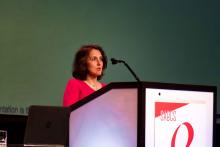SAN ANTONIO – For postoperative breast cancer patients with a high risk of recurrence, the oral fluoropyrimidine-based drug S-1 could boost benefits of standard adjuvant treatment, based on results from the Japanese phase 3 POTENT trial.
Adding S-1 to endocrine therapy increased 5-year invasive disease-free survival (iDFS) by approximately 5% among patients with hormone receptor (HR)–positive, HER2-negative breast cancer, reported lead author Masakazu Toi, MD, PhD, of Kyoto University Hospital in Japan, and colleagues.
S-1 is a combination drug based on a biochemical modification of fluorouracil, with components aimed at potentiating activity and reducing gastrointestinal toxicity, Dr. Toi said at the San Antonio Breast Cancer Symposium.
Session moderator Carlos Arteaga, MD, of the University of Texas, Dallas, said that standard adjuvant treatment for breast cancer may evolve over the next few years, with S-1 representing one of several novel approaches currently under investigation.
“We’re all trying to optimize adjuvant endocrine therapy for patients that need it,” Dr. Arteaga said. “One approach is to add chemotherapy for those with a high-risk recurrence score. The other one is to … use CDK4/6 inhibitors in addition to endocrine therapy. … Clearly, endocrine therapy works in a majority of patients but in some it’s not sufficient, and we need to add a second intervention—that could be chemo in some cases, or it could be CDK4/6 inhibitors, if those trials pan out. This is another [strategy].”
The open-label POTENT trial was conducted at 139 centers in Japan, involving 1,932 patients with stage I-IIIB HR-positive, HER2-negative postoperative breast cancer who had intermediate to high risk of recurrence. Patients were enrolled within 1 year of surgery and 6 months of starting adjuvant therapy.
Patients were randomized at a 1:1 ratio to receive either standard endocrine therapy or endocrine therapy plus S-1, with S-1 given on a 2-weeks-on/1-week-off basis for 1 year. The primary endpoint was iDFS, defined as time from randomization to invasive disease recurrence, occurrence of second invasive cancer event, or death
After a median follow-up of 51.4 months, iDFS events were significantly more common in the control arm than the S-1 arm (15.9% vs. 10.6%; hazard ratio, 0.63; P = .0003). This translated to an estimated 5-year iDFS of 81.5% among patients who received endocrine therapy alone versus 86.9% among patients who also received S-1 (P less than .001).
While adding S-1 to endocrine therapy did increase the rate of adverse events, most instances were mild, leading the investigators to describe the novel regimen as “well tolerated and manageable.”
Among severe adverse events, grade 3-4 diarrhea and neutropenia were significantly more common in the S-1 arm than the control arm, with diarrhea occurring at a rate of 1.9% versus 0%, respectively, and neutropenia occurring at a rate of 7.5% versus 0.7%, respectively.
Based on these findings, Dr. Toi concluded that adding S-1 could be a viable option for improving outcomes in select patients.
“Our findings support the addition of S-1 to standard endocrine therapy in the postoperative adjuvant setting for patients with HR-positive/HER2-negative disease and an intermediate or higher risk of recurrence,” Dr. Toi said.
But according to invited discussant Priyanka Sharma, MD, of the University of Kansas, Kansas City, a place for S-1 in the clinic remains to be seen, partially because of potential differences in fluoropyrimidine drug metabolism based on ethnic background.
“The POTENT trial design does not allow us to discern in which setting and patient population addition of S-1 is most meaningful,” Dr. Sharma said. “This trial was done in Japan, so efficacy and toxicity in a non-Asian population is unclear.”
The study was funded by the Comprehensive Support Project for Oncology Research of the Public Health Research Foundation and Taiho Pharmaceutical. The investigators reported additional relationships with Bristol-Myers Squibb, Daiichi Sankyo, Genomic Health, and others.
SOURCE: Toi M et al. SABCS 2019, Abstract GS1-09.




